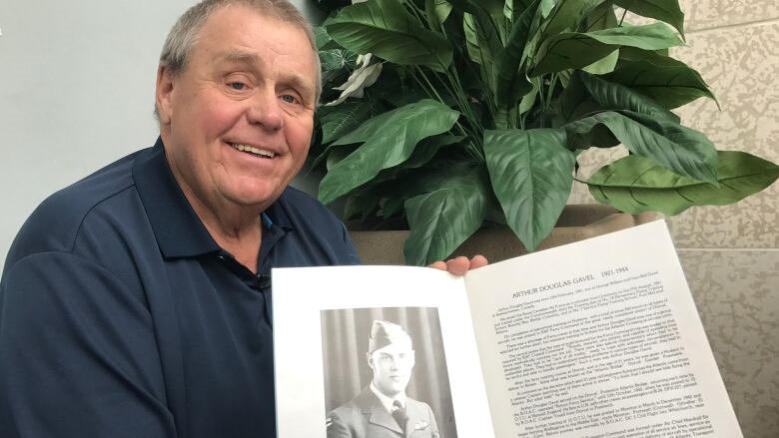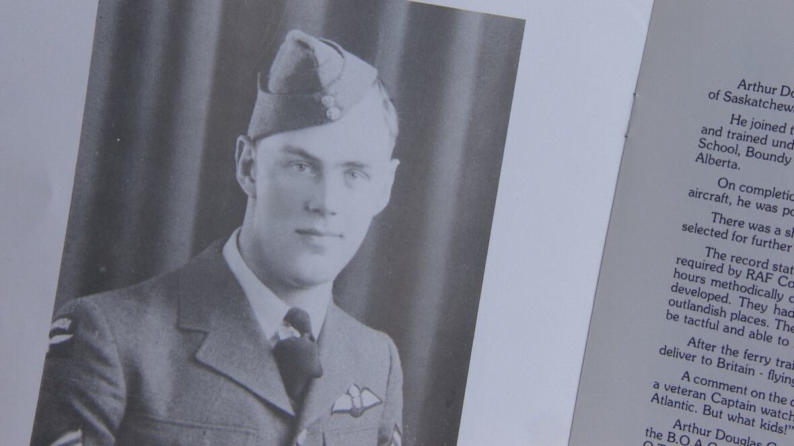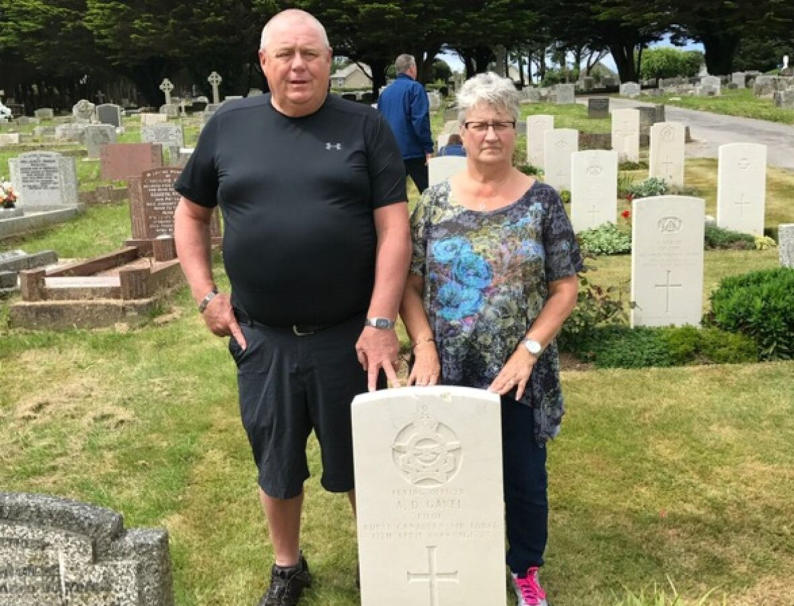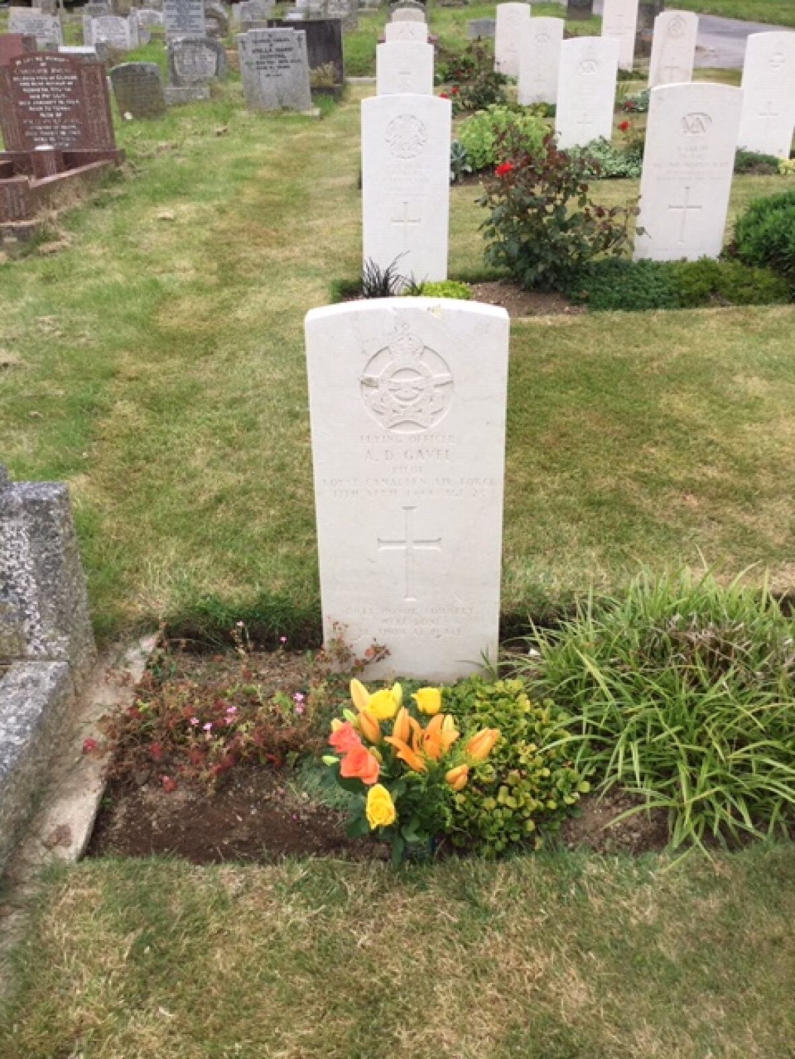
copyright © Wartime Heritage Association
Website hosting courtesy of Register.com - a web.com company
Wartime Heritage
ASSOCIATION
News Archive
By Janani Whitfield, CBC News
Regina's Lowell Gavel has learned much about the mysterious circumstances surrounding his uncle's death during the Second World
War, but it was only recently that he was able to visit Arthur Gavel's graveside in England and get a sense of closure. (CBC News)
Decades after his uncle's mysterious death in an aircraft explosion, Lowell Gavel stood by his uncle's graveside in an English
cemetery, overcome with emotion.
The Last Post played as he paid homage to the uncle he never knew.
"It was just a relief to the whole family. Finally a grave, and knowing his body wasn't in the sea," the Regina man said of
learning what happened to his uncle, RCAF Flying Officer Arthur Gavel.
Arthur, who was from Swift Current, Sask., was 23 years old in April 1944 when he climbed aboard his plane — a Vickers
Warwick Mark I, according to the Wartime Heritage Association — at RAF Lyneham in Wiltshire, U.K.
He couldn't have imagined his end was so near.
RCAF Flying Officer Arthur Gavel died in 1944, when his plane exploded shortly after takeoff. It took decades for his family to learn
what happened to his body.
"When they were ready to take off on the tarmac, something unusual happened," Lowell told CBC Saskatchewan's Morning
Edition.
"The plane was stopped and a courier package was taken out, and put on the flight deck of the plane. Packages were never,
ever flown on the flight deck."
Double-agents and gold bullion:
Years later, speculation continues to run rampant about what was in the package, and who might have brought it aboard.
Attention has turned to two French interpreters aboard the plane who might have been double-agents, while rumours swirl
that gold bullion was at the bottom of the plane, destined to fuel the resistance abroad.
While those questions remain sunk in mystery, the end of the Vickers Warwick is more definite.
Once the plane took off from the air force station, it was only three minutes before there was an explosion that brought the
aircraft, and the 16 people aboard, down into the sea.
Fourteen bodies quickly washed to shore and were identified, with the co-pilot's body washing up soon afterward.
"My uncle was never identified because he didn't wash up for two weeks," said Gavel, explaining there was no one left in the
squadron to identify his body. None of the people had been wearing dog tags or had identification of any other kind.
Laid to rest in unmarked grave:
The man was laid to rest in an unmarked grave, with no one ever knowing for certain the identity of the body that washed up
weeks after the aircraft disaster.
It was not until Derek Fowkes, a police inspector and amateur historian, began digging into wartime records that this mystery
would be solved. He worked with the Gavel family to get the body exhumed, and match dental records to make a positive ID
of the body.
That identification came as a huge relief to the family, said Lowell, 40 years after Arthur's untimely death.
"My grandmother, she spent her whole life after that in and out of mental institutions
— just the fact there was no body and no grave."
Lowell and Jeanette Gavel were among the family members who visited the English graveside of Lowell's uncle in the
summer of 2017. (Submitted by Lowell Gavel)
Last summer, Gavel and other members of his family flew to England to visit Arthur Gavel's gravesite.
The ancient graveyard had a look of neglect, overrun with weeds and ugly looking, Gavel recalled. But an old-timer who saw
them searching came over and pointed them to the section that held the military graves.
There, the family was surprised to find meticulously tended grave markers, with fresh flowers to lay for Arthur Gavel.
"The local veterans keep the military graves just spotless and perfect," said Gavel.
There, they paid their respects.
"It was just finally — closure."
While the New Quay Cemetery had an air of neglect, military graves on the site are tended carefully, including that of
Arthur Gavel. (Submitted by Lowell Gavel)
__________________
You can also read the Association’s story: Mystery Flight – April 17, 1944
525 Squadron, Royal Air Force




Family finds closure in visit to long-missing Second World War officer's
grave. Arthur Gavel died in mysterious plane explosion in 1944
November 9, 2018


- World War I - Menu
- WWI Stories and Articles
- Photos - Yarmouth Soldiers
- Selection of World War I Songs
- WWI Casualties of Yarmouth, NS
- Those Who Served - Yarmouth, NS
- WWI Casualties Digby Co. NS
- WWI Casualties Shelburne Co. NS
- Merchant Mariners (1915) Yarmouth, NS
- Canadian Forestry Corps - Non Yarmouth Birth/Residence Enlistments
- US Draft Registry - Yarmouth NS Born


- World War II - Menu
- WWII Stories and Articles
- Telegraphist Air Gunners
- WWII Casualties of Nova Scotia
- US Casualties with NS Connection
- Far East/Pacific Casualties with NS Connection
- Merchant Navy Casualties Nova Scotia
- Nova Scotia WWII Casualties Holten Canadian War Cemetery
- D-Day Casualties - Nova Scotia
- CANLOAN Program Casulaties - Nova Scotia
- Battle of the Bulge Casualties - Nova Scotia
- WWII Casualties Yarmouth NS
- Yarmouth Casualties - RCAF RAF Canadian Army WWII
- Yarmouth Co., Marrages WWII
- Casualties Non-Born/Residents with Connection to Yarmouth Co., Nova Scotia.
- WWII Casualties Digby Co., NS
- Non-Nova Scotian WWII Casualties Buried in Nova Scotia
- WWII RCAF Casualties Aged 16-18
- Brothers/Sisters Who Served - World War II













